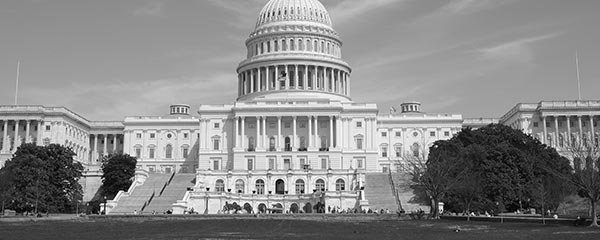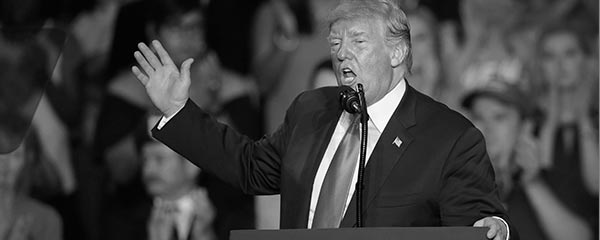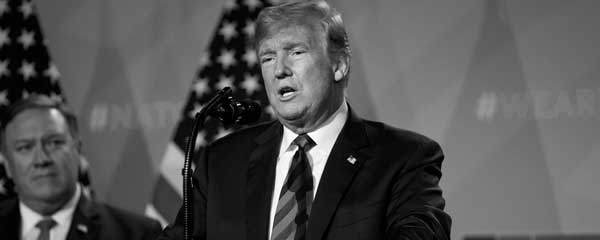Story Highlights
- Americans' trust in legislative branch is 40%, up slightly from 35%
- Uptick caused by increased confidence among Republicans
- 42% in U.S. have trust in executive branch and 68% in judicial branch
WASHINGTON, D.C. -- Americans' trust and confidence in the legislative branch of the U.S. federal government is at its highest point in nine years, with 40% saying they have "a great deal" or "a fair amount" of trust in it. This latest confidence reading marks a slight, five-percentage-point uptick for the legislative branch since last year and brings it in line with the executive branch's 42% confidence rating for the first time in a decade. The judicial branch continues to inspire the most trust with a 68% confidence rating.
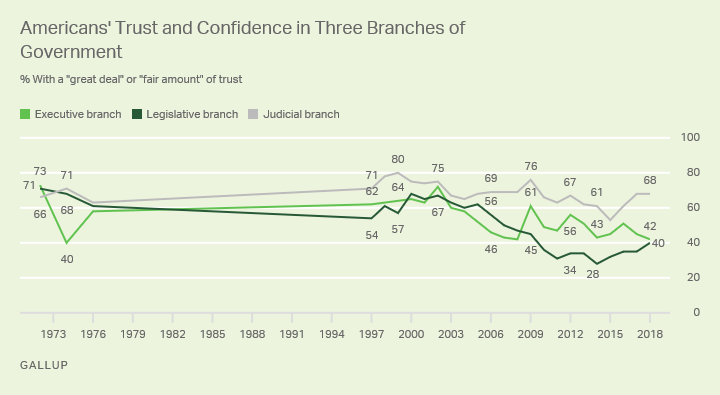
���۴�ýhas measured trust in the three branches of government since 1972, including annually since 1997, with the latest readings coming from a Sept. 4-12 poll. The current reading was taken during the Senate Judiciary Committee's first-round confirmation hearing of President Donald Trump's controversial Supreme Court nominee Brett Kavanaugh, but before last week's high-drama congressional hearings on allegations that Kavanaugh had engaged in an act of sexual assault.
Although overall trust in the U.S. House of Representatives and Senate, identified as "the legislative branch" in this measure, has risen slightly among all Americans in the past year, it nonetheless remains well below the historical average of 50% dating back to 1972. The public's trust in the judicial and executive branches is flat compared with last year, but trust in the judicial branch matches its historical average while the reading for the presidency is well below its 54% historical average.
Americans had the most trust in the three branches collectively before the Watergate crisis in 1974 and again in the late 1990s and early 2000s, largely because of a strong economy and the rally effect after the 9/11 terrorist attacks.
Legislative Branch
Since 2008, trust in the legislative branch has been below 50% among all Americans. Yet, between 1997 and 2007, confidence never fell below 50% and was as high as 68% in 2000.
The current slight increase in the public's overall trust in Congress is solely the result of increased confidence from Republicans and Republican-leaning independents. There has been no change among Democrats and Democratic-leaning independents' confidence since 2016.
Before this year, there had been little divergence in partisans' confidence in Congress, with the exception of 2007 through 2010, when Democrats controlled both the U.S. House and the Senate. During that time, Democrats and Democratic leaners had much higher confidence levels than their Republican counterparts.
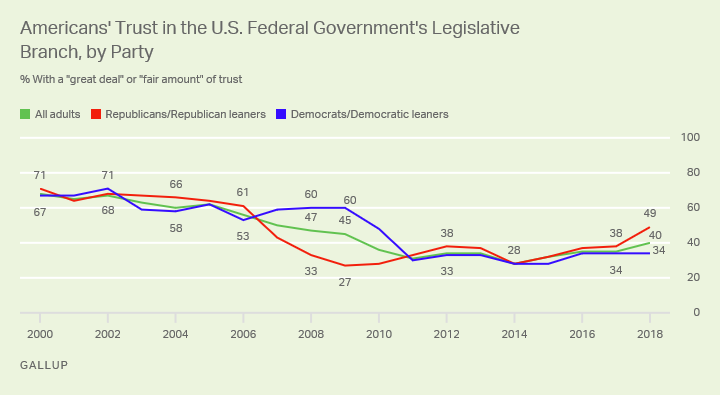
Rank-and-file Republicans' faith in the legislative branch began to inch up in 2015, when Republicans became the majority party in both houses. Yet a much more significant change came in the latest reading, which saw a one-year, 11-point increase in trust to 49% -- perhaps because Republicans in Congress have made progress in enacting the GOP agenda, most notably by passing income-tax cuts. Still, Republicans' confidence in Congress has not reached the majority level as Democrats' did when they controlled both houses.
Executive Branch
Trust in the executive branch in 2018 is similar to last year's 45% and is consistent with Trump's middling job approval. The current reading is not much higher than Gallup's historical low point in trust in the executive branch, 40% in April 1974 during Watergate. There have been other similar readings more recently, including three times under George W. Bush (2006-2008), and four times under Barack Obama (2010-2011 and 2014-2015).
Americans' trust in the executive branch continues to show dramatic partisan divergence, by far the most of the three branches. This follows the expected pattern whereby partisans have more trust in the executive branch when the president is from their own party, while partisans of the opposing party have less faith.
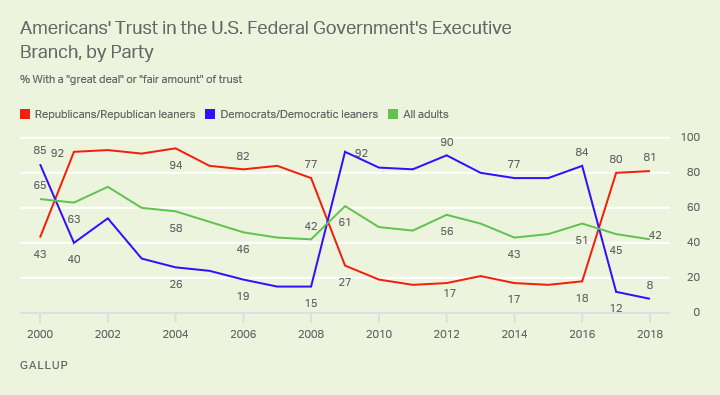
The current 73-point partisan gap in executive branch confidence readings ties as the largest since 2000, matching the 2012 gap when Obama was in office.
Judicial Branch
Trust in the judicial branch has consistently been the highest of the three branches and currently matches last year's reading. The historical high of 80% was in February 1999.
The current trust level is well above the historical low of 53% in 2015, which was most likely in reaction to contemporaneous Supreme Court decisions that in effect upheld the Affordable Care Act and legalized gay marriage.
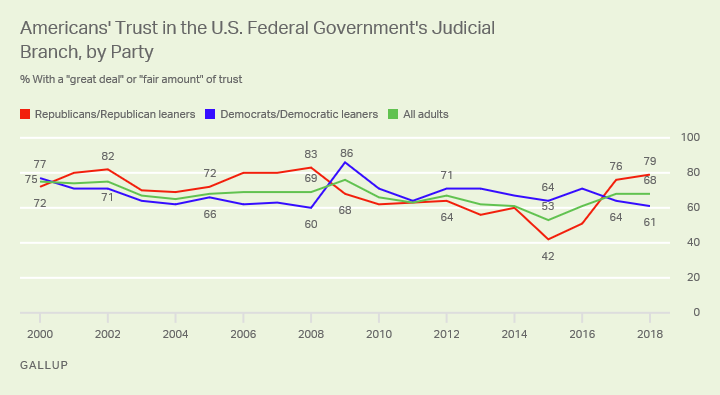
Bottom Line
Americans have similar levels of trust in the legislative and executive branches of the federal government. As is typically the case, trust in the judicial branch is much higher.
Although trust in the executive and judicial branches hasn't changed over the past year, Republicans' trust in the legislative branch has risen sharply, in turn responsible for an uptick in overall confidence in Congress as the midterm elections draw near. The public's approval rating of Congress, although it has been at or below 20% for the past 12 months, finds Republicans' approval much higher than Democrats' and up sharply compared with a year ago. History has shown that changes in party control of Congress result in changes to partisans' confidence in the institution. Thus, if party control changes next month, the upcoming elections may have such an effect on trust levels.
View complete question responses and trends.
Learn more about how the works.

